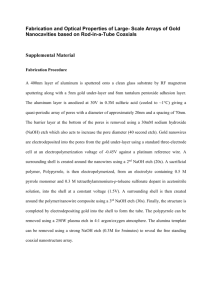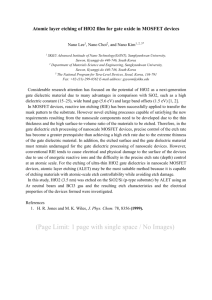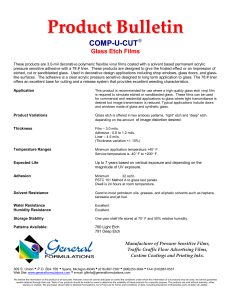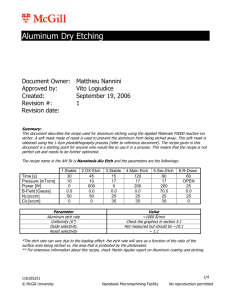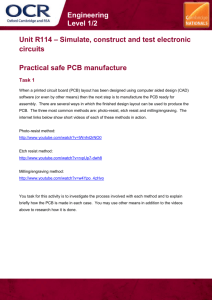hw 7 - Personal.psu.edu
advertisement
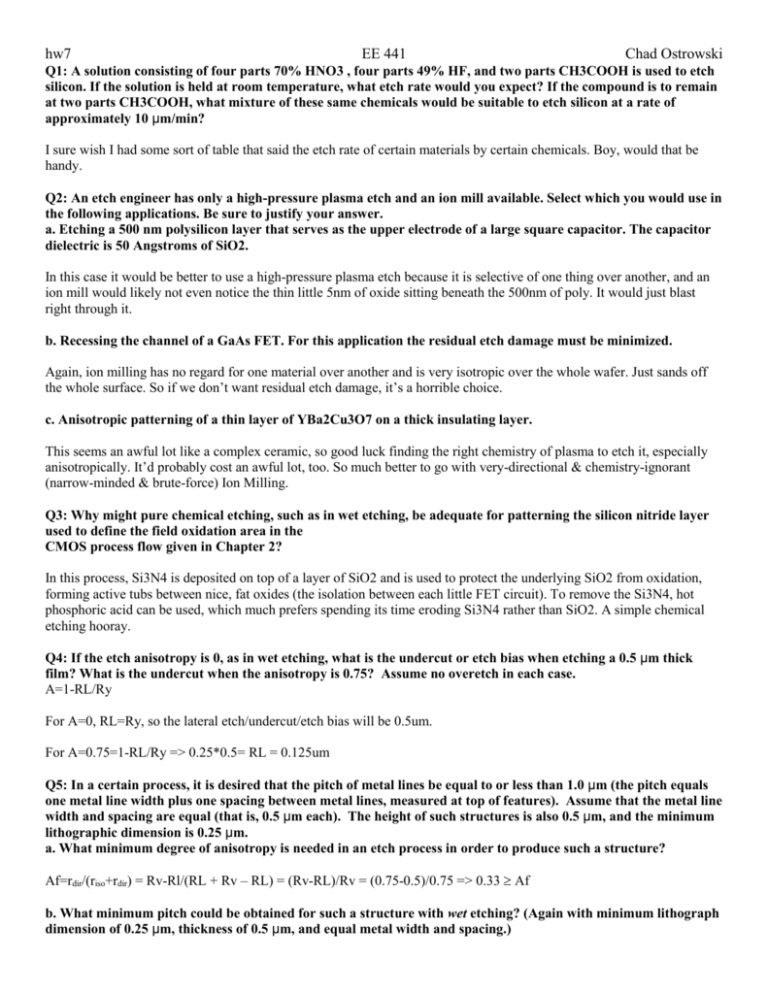
hw7 EE 441 Chad Ostrowski Q1: A solution consisting of four parts 70% HNO3 , four parts 49% HF, and two parts CH3COOH is used to etch silicon. If the solution is held at room temperature, what etch rate would you expect? If the compound is to remain at two parts CH3COOH, what mixture of these same chemicals would be suitable to etch silicon at a rate of approximately 10 μm/min? I sure wish I had some sort of table that said the etch rate of certain materials by certain chemicals. Boy, would that be handy. Q2: An etch engineer has only a high-pressure plasma etch and an ion mill available. Select which you would use in the following applications. Be sure to justify your answer. a. Etching a 500 nm polysilicon layer that serves as the upper electrode of a large square capacitor. The capacitor dielectric is 50 Angstroms of SiO2. In this case it would be better to use a high-pressure plasma etch because it is selective of one thing over another, and an ion mill would likely not even notice the thin little 5nm of oxide sitting beneath the 500nm of poly. It would just blast right through it. b. Recessing the channel of a GaAs FET. For this application the residual etch damage must be minimized. Again, ion milling has no regard for one material over another and is very isotropic over the whole wafer. Just sands off the whole surface. So if we don’t want residual etch damage, it’s a horrible choice. c. Anisotropic patterning of a thin layer of YBa2Cu3O7 on a thick insulating layer. This seems an awful lot like a complex ceramic, so good luck finding the right chemistry of plasma to etch it, especially anisotropically. It’d probably cost an awful lot, too. So much better to go with very-directional & chemistry-ignorant (narrow-minded & brute-force) Ion Milling. Q3: Why might pure chemical etching, such as in wet etching, be adequate for patterning the silicon nitride layer used to define the field oxidation area in the CMOS process flow given in Chapter 2? In this process, Si3N4 is deposited on top of a layer of SiO2 and is used to protect the underlying SiO2 from oxidation, forming active tubs between nice, fat oxides (the isolation between each little FET circuit). To remove the Si3N4, hot phosphoric acid can be used, which much prefers spending its time eroding Si3N4 rather than SiO2. A simple chemical etching hooray. Q4: If the etch anisotropy is 0, as in wet etching, what is the undercut or etch bias when etching a 0.5 μm thick film? What is the undercut when the anisotropy is 0.75? Assume no overetch in each case. A=1-RL/Ry For A=0, RL=Ry, so the lateral etch/undercut/etch bias will be 0.5um. For A=0.75=1-RL/Ry => 0.25*0.5= RL = 0.125um Q5: In a certain process, it is desired that the pitch of metal lines be equal to or less than 1.0 μm (the pitch equals one metal line width plus one spacing between metal lines, measured at top of features). Assume that the metal line width and spacing are equal (that is, 0.5 μm each). The height of such structures is also 0.5 μm, and the minimum lithographic dimension is 0.25 μm. a. What minimum degree of anisotropy is needed in an etch process in order to produce such a structure? Af=rdir/(riso+rdir) = Rv-Rl/(RL + Rv – RL) = (Rv-RL)/Rv = (0.75-0.5)/0.75 => 0.33 Af b. What minimum pitch could be obtained for such a structure with wet etching? (Again with minimum lithograph dimension of 0.25 μm, thickness of 0.5 μm, and equal metal width and spacing.) hw7 EE 441 Chad Ostrowski A=1-RL/Rv = 1-0.5/0.75 = 0.33 A Q6: It is found that a certain plasma etch chemistry in a certain RIE etch system produces vertical sidewalls with zero etch bias when etching a particular film. Adding chemical A to the etch chemistry results in non-vertical sidewalls, and an etch bias. Adding chemical B to the original etch chemistry results in non-vertical sidewalls, but with zero etch bias. Explain what may be going on. It seems like Chemical A may be creating an energy-driven anisotropy, in which bombarding particles quickly etch horizontal surfaces & slowly etch vertical ones (the walls). The high energy makes a bias. Chemical B, however, seems to be creating an inhibitor-driven anisotropy, which can make a thin film develop on the etch surface but won’t provide enough energy for a bias. Q7: If the anisotropy of an etch process is 0.45, sketch the etch profile. What percentage of the etch rate in the vertical direction is due to the chemical component and what percentage is ionic/physical, assuming a linear etch mechanism? State all assumptions. A=1-RL/Ry = 0.45 => RL/Ry=0.55 => RL = 0.55 Ry This means that the lateral etch is nearly the same as the vertical etch, a characteristic of chemical etches. This means that about 10% of the etch is ionic/physical, and the other 90% is chemical: Q8: In an etch process, there is a finite amount of purely chemical etching without any ion bombardment (i.e. spontaneous chemical etching). In addition, ion bombardment greatly increases the etch rate by facilitating the breaking up of the etch precursor. At high ion flux the etch rate saturates. No etching occurs when there is only ion bombardment with no chemical component. a. Write a generalized etch rate equation that can describe this behavior. Etch Rate = (ScKfFc + KiFi)/N b. Sketch an etch rate versus ion flux curve for this process for some non-zero chemical flux. c. Sketch what the etch profile might look like for this process (i.e. etching through a window in a mask as in Figure 10-3).


